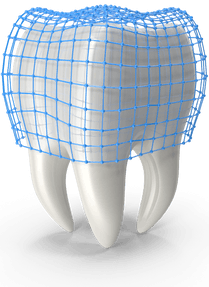
Cosmetic Dentistry at Morris Family Dentistry

Bridges & Crowns

Composite Bonding

Teeth Whitening

Veneers
Bridges & Crowns
Both bridges and crowns strengthen weakened teeth by covering and surrounding them 360 degree. Crowns cover a single tooth. Bridges cover multiple teeth, replacing any missing teeth in between. Veneers, however, cover the only front surface of a tooth, and are primarily used to improve the aesthetics of your smile.
Crowns
When a tooth has been weakened by root canal therapy or a large filling, it should be covered with a crown. When a tooth doesn’t get needed crown it cracks and splits under chewing pressure. Sometime the split cannot be repaired and the tooth has to be extracted. If weakened teeth receive a crown soon after a root canal, the tooth can be saved.
When crown is made for a tooth it is first numbed and shaped to have an even taper from top to bottom. This shape will allow the crown to slide down and fit snugly over the tooth. An impression of the tooth is made, and a temporary crown covers the tooth while the dental lab makes the permanent crown. Later the temporary crown is removed and the permanent crown is cemented. Crowns can be made of porcelain (for superior aesthetics) or of gold (on back teeth where chewing and grinding forces are greater). Crowns last on average 10 years or more.
Bridges
A bridge replaces missing teeth when there are existing teeth on both sides of the space. Crowns cover these adjacent teeth with the replacement teeth attached in between the crowns. Because a bridge is a single piece of porcelain connecting the teeth, you can’t floss a bridge like you would the other teeth. Floss must be passed under the bridge from the side to keep gums healthy and prevent decay on the roots of the teeth that support the bridge.

Composite Bonding
Composite filling material can be bonded on the front teeth to improve the cosmetic appearance. The patient shown below drank 5 or 6 sodas a day and had poor home care. The result was decay in multiple teeth. After the teeth were anesthetized and the decay removed, composite was bonded to restore the form, function, and esthetics of his teeth and smile.
In conjunction with these cosmetic services, consider whitening the teeth first for a brighter smile and better final result. Improving the appearance of your smile will increase your confidence and happiness. A recent study suggested that a more aesthetic smile can even improve your success in the workplace. Consult with us about how we can help you get the smile you’ve always wanted.
Internal Bleaching
In some cases a single tooth will darken. This can happen when that tooth has had a root canal. If this tooth has already had a root canal we can do internal bleaching. With internal bleaching, the peroxide is placed inside the back of the tooth and covered with a temporary filling. Because the tooth has already had a root canal, it doesn’t need to be numbed and the procedure is painless. The peroxide brightens the tooth from the inside out. Each week the shade is checked and fresh peroxide placed until the tooth is brightened to the match the shade of the other teeth. Once the tooth is the correct shade, the temporary filling is replaced with a permanent filling.

Veneers
Veneers are a thin porcelain facing bonded by strong cement to the front surface of the teeth for aesthetic improvement. Veneers can correct problems of stain, discoloration, or crooked or poorly shaped teeth.
The patient shown on the left didn’t like the stain or general yellow color of her teeth. She also had old discolored fillings and areas of recession, root exposure, and tooth sensitivity. To correct these problems she had 10 veneers made for the upper teeth and 10 for the lower teeth. She was thrilled with the appearance of her teeth, felt confidence to smile more often, and had much less sensitivity of the teeth.
Call us now
For Dental Implant services, call 303-795-1443 today for an appointment!
Call us at (303) 795 1443
